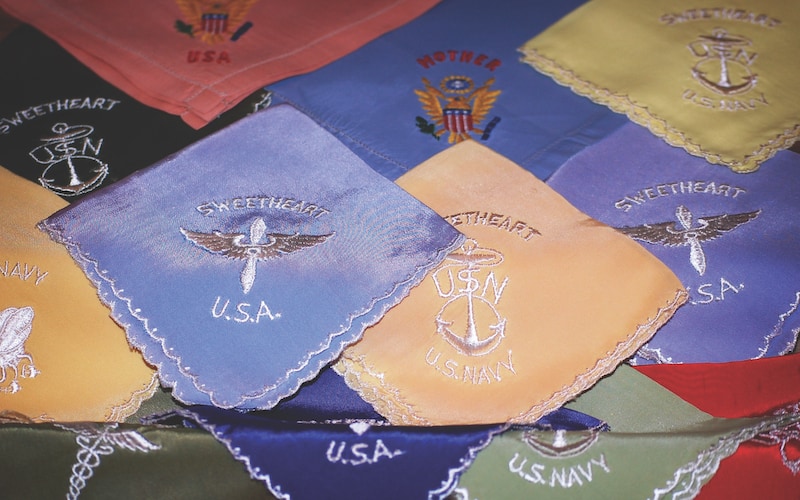Since as far back as the Chou dynasty (around 1000 B.C.), kerchiefs have served as head coverings. These decorative cloths were once considered status symbols and were associated with the wealthy. Later on, in Roman culture, kerchiefs were downsized to handkerchiefs and were often waved by spectators as a show of appreciation at athletic competitions. By the 14th century, handkerchiefs, popular with aristocrats, were being fashioned from finely embroidered precious silk in square, round or rectangular shapes. History reports that Marie Antoinette, frustrated by so many shapes, asked her husband, King Louis XVI, to decree that all handkerchiefs be uniformly square. He did, and except for slight variations, they have not changed to this day.
It was during the reign of Queen Elizabeth I that handkerchiefs really came into their own. At court, they were often presented as gifts to those whom Elizabeth favored. It wasn’t long before this little, often scented, fashion accessory became popular as a token of affection and an instrument of flirtation. By the end of the 1800s, it was a common practice for women to use handkerchiefs to signal their romantic intentions. Author Helen Gustafson in her book Hanky Panky lists some of these flirtatious signals. For example: Drawing a handkerchief across the lips meant “I desire to make your acquaintance,” drawing one across the eyes indicated “I am sorry,” drawing one across the cheek said “I love you,” and twisting one in the right hand relayed “I love another.”
In the 1920s, Kleenex introduced disposable tissues for makeup removal. Before long an advertising promotion followed with the slogan “Don’t carry a cold in your pocket.” Many people thought associating hankies with disease would signal the end of their popularity. But the cotton icon was not to be so easily discarded.
After centuries of wiping little noses, dabbing away tears and signaling romantic intentions, the lowly cloth became adapted as a stylish fashion accessory. Known as a “pocket square,” this trendy diminutive hanky was popularized by such movie legends as Fred Astaire and Cary Grant. Pocket squares, which are still popular today, differ from traditional handkerchiefs in that they are usually made of silk or a synthetic blend instead of cotton, are thinner and smaller, and have a rolled hem. There are even different types of folds for the square, such as the Presidential, the Winged Puff, the Reverse Puff and the Three-Point Fold. Mastering these ritualized forms is a must for any dapper dresser.

Michelle Lanctot of Dahlonega remembers that era well. “I grew up in a very formal household with an aristocratic British grandmother and a mother who strictly followed traditional social customs. Proper little girls always carried two clean hankies, one to use and one to share. We never used synthetic, only cotton or silk, and usually plain white with lace accents. My mother always said that a lovely lace hankie was an appropriate gift for any occasion. To this day I still carry white lace handkerchiefs.”
Jeanne Bilbery, co-owner of the Corner Cupboard in Clarkesville, has similar recollections of the 1950s. “I remember as a child that we always had to have hankies with us when we went to church, along with our gloves and little purse. Women carried them everywhere, even in their evening bags. If they weren’t in our purse, they were peeking out of a jacket pocket, draped over a belt, tucked up the sleeve of our sweaters or tied around our wrists. I’ve always had a fascination with them. I especially like the brightly patterned ones with artistic designs.”
Bilbery’s infatuation with the colorful squares is evident in her choice of inventory for the store, where she displays multiple racks of neatly folded, washed and ironed hankies. “For decades, handkerchiefs have remained a steady seller. I usually sell mine for about half of the retail price online. They are available in a variety of categories, including traditional white lace, designer art, souvenir travel hankies, holiday patterns and children’s hankies. Always one of my favorite finds is the World War II military handkerchiefs that were sent to mothers, sisters and sweethearts from men in the armed services. They are such a romantic reminder of our past.”
Vintage handkerchiefs are readily available online or at your favorite antiques store and are usually priced under $10. So let the hunt begin.
- The list of handkerchief signals used for flirtation is extensive and may be found online at www.geriwalton.com. Search for “handkerchiefs and flirting language.”
- A large and colorful selection of handkerchiefs can be found at www.etsy.com. Search for “vintage handkerchiefs.”
- For craft ideas that make use of hankies, visit www.houseofhawthornes.com and search for “vintage hankies.”
